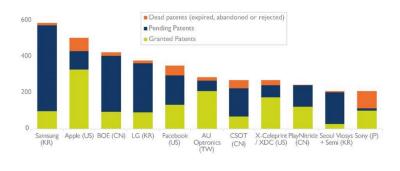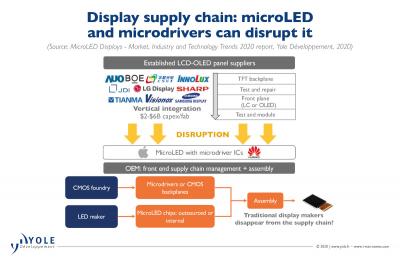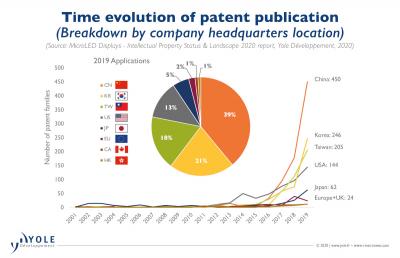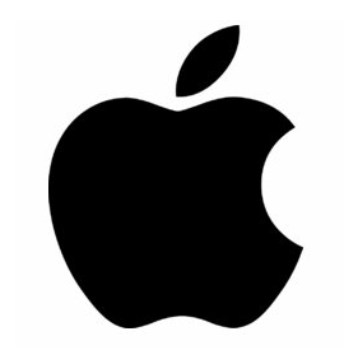 Apple, one of the world's largest companies, develops consumer electronics and computer software, and the company also develops a wide range of next generation technologies.
Apple, one of the world's largest companies, develops consumer electronics and computer software, and the company also develops a wide range of next generation technologies.
In 2014 Apple acquired MicroLED display developer LuxVue Technology. LuxVue raised $43 million in funding prior to the Apple purchase. Since the LuxVue acquisition, Apple accelerated its MicroLED R&D project and developed solutions for smartwatches, AR and other display types. Apple established a dedicated microLED research and production facility in Taoyuan, Taiwan, and according to reports, Apple invested over $3 billion on microLED R&D. In early 2024, Apple decided to cancel its MicroLED smartwatch display project, and it's current microLED plans are unknown.
Apple microLED Watch
Apple developed MicroLED technologies for many years , and its first goal was to adopt microLED displays in smart watch devices. The latest Watch devices use LTPO OLED displays, but a microLED display could enable Apple to extend the Watch battery life and increase its brightness. As we said, the project was cancelled in early 2024, but it is likely that if display developers commercialize microLEDs, Apple could adopt these for future watch devices.
1 Infinite Loop
Cupertino, CA 95014
United States
Samsung Display looks to commercialize smartwatch microLED displays by the end of 2023
ETNews says that Samsung Display has launched a new project to develop microLED displays for smart watch applications. The company setup a new development team, with a goal to commercialize this technology and move it beyond its current R&D stage.
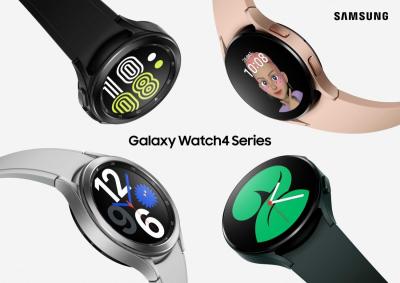
Samsung's plan, it seems, is to complete the development by the end of 2023, and then look into mass production, aiming to supply such displays to Tier-1 wearable makers such as Apple and Samsung Electronics.
Apple to release a microLED display powered Watch in 2024, according to rumors
There are some new rumors (or analyst estimates, really) that Apple is working to adopt a microLED display in its next Watch Ultra smartwatch, to replace the currently-used OLED display. The new display, according to what we hear, will have a 2.1" display. Apple aims, it seems to release its first microLED display powered device in 2024, or even possibly 2023.
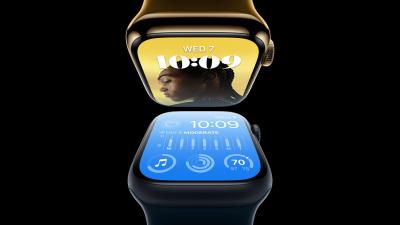
The current (Gen-1) Watch Ultra has an advanced 1.92" (49 mm) 2000 nits 502 x 410 pixels LTPO AMOLED display.
Some Apple users complain of blooming in the latest miniLED displays
Apple's latest iPad Pro tablets use a mini-LED backlit LCD (which Apple refers to as Liquid Retina XDR). While most reviews of the new display are quite positive, some users are complaining of "blooming" - the edges of bright objects on dark backgrounds tend to 'bleed' as the dimming zone is not small enough.
miniLEDs improve over LCD as they introduce thousands of dimming zones, which increases contrast and improves power consumption. The dimming zones, however, are sometimes not small enough, as some users find out, and cannot compete with an emissive technology such as OLED or microLED.
Yole Developpement says rate of MicroLED patent submission is rising sharply
Yole: micro-IC based microLED production could lead to large disruptions in the display industry
Display market analysts from Yole Developpement posted an interesting article, that speculates that Apple and Huawei are looking into microLED displays based on Si-CMOS micro-ICs. This model could have tremendous implications for the display market.
The idea is that the device maker (Apple is likely to be the first to go down that route) will source micro LEDs from LED producers (or produce these in-house) and source microICs from foundries. Apple could then assemble these into its own displays, in-house. This means that in this model there's no room for traditional display makers which could lead to large disruptions in the display market, according to Yole.
Apple, AUO and Epistar to establish a $334 million mini-LED and micro-LED production fab in Taiwan?
According to a report from Taiwan's Economic Daily news, a new mini-LED and micro-LED display factory is under planning in Taiwan's Hsinchu Science Park. The new fab is built by Apple (who will invest $334 million) in collaboration with AU Optronics and Epistar.
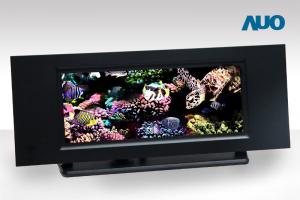
According to the report, the Science Park Administartion approved Apple, Auo and Epistar's plan on February 18. The new fab will act as an expansion of Apple's existing display center in Taiwan.
Yole Developpement: the rate of MicroLED patent filing is rising exponentially
Yole Developpement reports that about 5,500 microLED patents (2,500 patent families) have been filed, by more than 350 organizations. The rate of patent filing is growing exponentially - 40% of the patents were filed in 2019.
According to Yole, the recent patent filing shows that the industry is moving from prototypes to commercial consumer displays. Other notable new finding include that startup companies are a major innovation force, Apple is slowing down with its IP (but this could mean that the company is now focused on commercialization), and Samsung pursues multiple development tracks. BOE is another strong microLED IP player, with almost 150 patent familiies filed in 2019.
Yole: microLED shipments to reach over 125 million panels by 2027
Market analysts at Yole Developpement say that microLED shipments will reach over 125 million panels by 2027. In their aggressive scenario, shipments will reach almost 450 million.
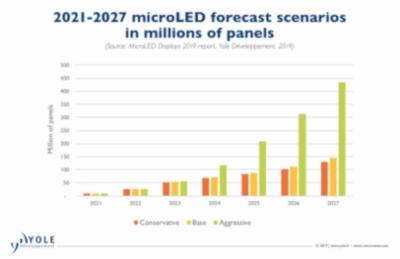
Yole says that microLED technologies are advancing rapidly - and on all fronts, but there are still many challenges to overcome before mass production arrives. MicroLED makes a strong case for the AR, smartwatch and automotive market. For the smartphones and TV markets it is less clear whether MicroLEDs could succeed.
Will PlayNitride and RiTDisplay supply Apple with MicroLED displays for future Watch devices?
According to Taiwan's Economic News Daily, PlayNitride and RiTDisplay are in talks with Apple to supply microLED displays for Apple's next-generation Watch wearable.
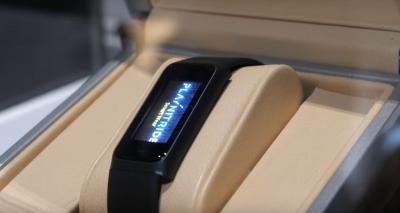
These are just rumors at this stage, but END says that PlayNitride confirms it is in talks with US customers regarding a 3" full-color Micro-LED display. This interesting as this is not a display we are used to see in most mobile devices - wearables are usually limited to around 1.5" while smartphones today start at around 6".
We talk Micro-LED technology and market with Yole Développement
Market research firm Yole Développement has been following the Micro-LED market for some years with some very interesting insights and forecasts.
Yole's technology & market analyst Zine Bouhamri was kind enough to discuss Yole's Micro-LED views with us. Mr. Zine is is a member of the Photonics, Sensing & Display division at Yole and he's deeply involved in the business development of the Displays unit activities.
Pagination
- Previous page
- Page 2
- Next page


